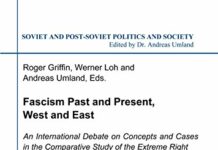
Ebook Info
- Published: 2018
- Number of pages: 180 pages
- Format: PDF
- File Size: 1.24 MB
- Authors: Roger Griffin
Description
The word ‘fascism’ sometimes appears to have become a catch-all term of abuse, applicable to anyone on the political right, from Hitler to Donald Trump and from Putin to Thatcher. While some argue that it lacks any distinctive conceptual meaning at all, others have supplied highly elaborate definitions of its ‘essential’ features. It is therefore a concept that presents unique challenges for any student of political theory or history. In this accessible book, Roger Griffin, one of the world’s leading authorities on fascism, brings welcome clarity to this controversial ideology. He examines its origins and development as a political concept, from its historical beginnings in 1920s Italy up to the present day, and guides students through the confusing maze of debates surrounding the nature, definition and meaning of fascism. Elucidating with skill and precision its dynamic as a utopian ideology of national/racial rebirth, Griffin goes on to examine its post-Second World War mutations and its relevance to understanding contemporary right-wing political phenomena, ranging from Marine Le Pen to Golden Dawn. This concise and engaging volume will be of great interest to all students of political theory, the history of political thought, and modern history.
User’s Reviews
Reviews from Amazon users which were colected at the time this book was published on the website:
⭐”The most influential recent attempt to define fascism comes from Roger Griffin, ‘The Nature of Fascism’ (London: Routledge, 1994), and ‘International Fascism: Theories, Causes, and the New Consensus’ (London: Arnold, 1998), though his zeal to reduce fascism to one pithy sentence seems to me more likely to inhibit than to stimulate analysis of how and with whom it worked” (Robert Paxton “The Anatomy of Fascism” loc. 4302).”The most widely accepted recent concise definition of fascism as an ‘ideal type’ is by the British scholar Roger Griffin: ‘Fascism is a genus of political ideology whose mythic core in its various permutations is a palingenetic form of populist ultranationalism'” (Robert Paxton “The Anatomy of Fascism” digital: loc. 415).”[Fascism] is a revolutionary form of nationalism. Therefore, [fascism] is different from Trump. If Trump came in and said, ‘I want to get rid of the American Constitution and wipe out elections …’ that for me, would push [Trump] into the camp of revolutionary nationalism. But, he’s populist precisely because he’s on the cusp. He’s supported by some fascists, but he’s within the Constitution and therefore, is populism–which is the danger now … compared with the fascism of the inter-war period” (Roger Griffin “What is Fascism?” video lecture ‘YouTube’ 57:00-57:36 12/03/17).
⭐Roger Griffin defines “Fascism” for Polity’s “Key Concepts in Political Theory”. That might not seem like something that would require 143 pages, but Griffin points out that “the attempt to arrive as a satisfactory definition of fascism has been likened to the mystical quest for the Holy Grail…and…’to searching for a black cat in a dark and possibly empty room’.” Griffin was among the scholars who created a conceptual framework and working definition of fascism in the 1990s, with his book “The Nature of Fascism”, that advanced the study of the concept by offering a heuristic definition that is at least not obviously false or unhelpful, as previous approaches have been. This book concerns itself chiefly with defining the term “fascism” –that is, generic fascism with a lower case F- and secondly with examining where fascism fits historically and in the present.Of the book’s six chapters, two are dedicated to definition and two to fascism in practice, while the others serve as introduction and conclusion. The books’ second chapter is dedicated to the definitions proposed by scholars prior to the 1990s, mostly to Marxist definitions, which saw fascism as a reactionary movement, an instrument of the bourgeoisie against the proletariat. Marxist definitions turned out to be demonstrably wrong when fascist political parties were subjected to some modern data analysis, but at least they were coherent. The author takes a dimmer view of the analyses of non-Marxist liberals who, like the Marxists, took an “outside in” approach to understanding (or not) fascism, that left non-Marxist studies of fascism in a “chaotic state.”The book’s third chapter offers a “conceptual framework… for studying generic fascism” based on “methodological empathy”. In other words, it considers what fascists say they are. Griffin cites the theories of historian George Mosse, who took a similar approach in the 1960s and was largely ignored. And Griffin offers his one-sentence definition: “Fascism is a genus of political ideology whose mythic core in its various permutations is a palingenetic form of populist ultranationalism.” Then he offers a lot of explanation. “Palingenesis” is a term of the author’s creation that refers to the fascist vision of national “rebirth”. Griffin is careful to note that, although an ideology, fascism is primarily about how that ideology translates into action. It is “practical rather than theoretical” as Mussolini, himself, said of his own Fascist –with a capitol F- party.The next two chapters discuss fascism in practice in the hope that it will clarify the definition somewhat. Chapter Four is dedicated to the fascism of the interwar years, 1919-1945. It looks primarily at Nazism and Italian Fascism, but also Romanian, Hungarian, as well as other fascism in partially Westernized parts of the world during that time. The author emphasizes the “extreme heterogeneity of fascist organic nationalism.” Chapter Five is about neo-fascism since World War II, which the author believes is “confined to a marginalized subculture” except in Hungary, Greece, and Slovakia. But he thinks that the internet has allowed fascism to form a permanent, latent “oppositional subculture” that may encourage radicalization.Roger Griffin believes that generic fascism is worthy of study because it can inspire extreme violence. And he wants people to understand that fascism is not right-wing populism that seeks to advance its agenda by democratic means. In order to study something, you need to define it. Honestly, I was not convinced that “fascism” is a real thing by the end of this book, especially not in the present world. Griffin’s definition seems prone to inclusion or exclusion based on fashion or agenda. Why are the Islamic State or, for that matter, Modern Zionism not considered fascist? They are both utopian ultranationalist projects with a strong palingenetic element. (Please note that this is not a comment on the legitimacy of these movements but on the definition of “fascism”.) Would any and every palingenetic nationalist movement in a nation that is not a liberal democracy be considered fascist? They are undemocratic, but so is the normal order that they wish to supplant.Griffin’s book is valuable in communicating the academic understanding of fascism and separating it from populism, but it did not convince me that there is any cat in that proverbial room. It also didn’t convince me that “the fascist project is always doomed to come to naught.” Of course, it is if it doesn’t normalize itself after a revolution has been achieved, but that is true of any revolutionary movement. In his chapter on “Interwar Fascism”, Griffin titillates us with the idea that Nazism’s “radical, totalizing experiment…can be seen as the very incarnation of modernism” and that the “dynamic, creative-destructive”, future-embracing aspirations of Nazi Germany and Fascist Italy qualify them as “modernist states”. Now that is an interesting interpretation. Expounding on those statements is beyond the scope of this book, but I believe Griffin has written more on the topic elsewhere.
⭐This is one of a trio of recent good short books about fascism that has recently been published, and should be widely read. But it should be noted that the other two—Madeleine Albright’s and Jason Stanley’s—more accessible and better written.
⭐This is a good overview of fascism. It is a term that gets thrown around a lot and even students of history sometimes struggle to really comprehend the term. Griffin starts with Marx and Mussolini, trying to grapple with the origins of it, then moves onto Max Weber and forming a prototype of fascism. He then applies to the the interwar years and WWII, then to the postwar era. He also considers more recent applications. I think this book is ideal for undergraduates who are studying the WWII era, but also for political science courses that might touch on this.
⭐This isn’t a casual reading book, but more along the lines of serious academic research. Honestly, it felt like an extension of my MA, which was fine. I appreciated the academic approach to this topic and wanted something that covered the history and scope of fascism. Overall, it was a good, academic read. Entertaining? It’s not a light read, but important.
⭐The statement “..the This Reich unilaterally terminated the pact on 22 Just 1941 with a large-scale attack in Russian positions in Poland” is propaganda-like misleading.After this I will not read further the book since I cannot trust it. I will ask Amazon if a refund is possible.
Keywords
Free Download Fascism (Key Concepts in Political Theory) 1st Edition in PDF format
Fascism (Key Concepts in Political Theory) 1st Edition PDF Free Download
Download Fascism (Key Concepts in Political Theory) 1st Edition 2018 PDF Free
Fascism (Key Concepts in Political Theory) 1st Edition 2018 PDF Free Download
Download Fascism (Key Concepts in Political Theory) 1st Edition PDF
Free Download Ebook Fascism (Key Concepts in Political Theory) 1st Edition

